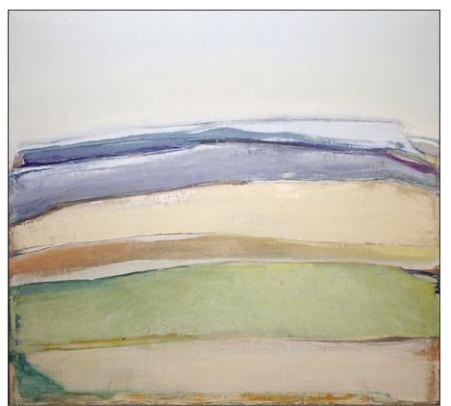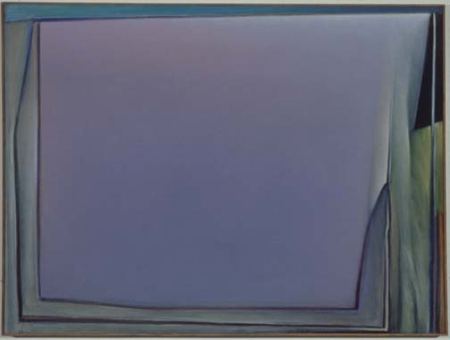On the West Coast, from Northern California to Seattle, a gestural
kind of painterly landscape abstraction took root in the 1950s and
1960s, sometimes but not always with figures in it.
Prime movers included David Park, Joan Brown, Elmer Bishop, Manuel Neri, Nathan Oliveira, Jay DeFeo, Richard Diebenkorn and, in Seattle, William Ivey, Boyer Gonzales, Margaret Tompkins, Robert C. Jones and Michael Dailey, who died this weekend after a brief illness.
Dailey was one of the youngest and most steadfastly abstract. Once he
found his style he didn’t change it until forced by health reasons.
(Early Morning Landscape, 1968, oil) In the 1960s, using oil paint, he began to make colors float. His canvases are full of ripe colors only loosely contained within their frames. I’ve always had the feeling if I put a finger under one of his buoyant passages, I could flip it into the air.
In the 1960s, using oil paint, he began to make colors float. His canvases are full of ripe colors only loosely contained within their frames. I’ve always had the feeling if I put a finger under one of his buoyant passages, I could flip it into the air.
That was enough for him, and he’d undoubtedly be doing it still had oil paint not become more than his balance and lungs could bear.
Dailey lived with multiple sclerosis since his 30s. While he loved the depth and illusion of oxygen he got from oil, he was ready to make the change when change was inevitable.
Acrylics took away his bounce, but what developed as a replacement has become as intriguing. Dailey painted flat smears of color that drag themselves across space and fight with their frames, which are constantly realigning their positions.
(Biscay Blue, acrylic/canvas, 2000)
 Seattle art museums being what they are, none has seen fit to provide one of the Northwest’s most singular colorists a retrospective, which is why the Greg Kucera Gallery joined forces with Dailey’s gallery, Francine Seders, to provide one last January.
Seattle art museums being what they are, none has seen fit to provide one of the Northwest’s most singular colorists a retrospective, which is why the Greg Kucera Gallery joined forces with Dailey’s gallery, Francine Seders, to provide one last January.
Dailey:
People have noted the complexity of my color and have given me credit for skill that more properly should be given to persistence and experimentation. This process of improvisation and revision has been the basis of my work since the beginning.
Born in Des Moines, Iowa, he received BA and MFA degrees from the University of Iowa. From 1963 to 1998, he taught painting and drawing in the School of Art at the University of Washington.
Besides Francine Seders, he is represented by Laura Russo Gallery in Portland, Oregon. His work is included in the collections of the Museum of Modern Art, The Smithsonian Institution, The Municipal Gallery of Modern Art, Dublin, Ireland, The Seattle Art Museum, The Tacoma Art Museum, the Portland Art Museum, and the University of Washington.
Dailey is survived by his wife Linda, son John, daughter Susanne Kelly, son-in-law Jeff Kelly and granddaughters Jane and Tess. Funeral services will be private.



Regina, your blog is a one-stop shop for all things in the Seattle visual arts world! I learn much each time I visit, and I enjoy it too!
Michael was an amazing artist and a very kind soul. He was humble and gifted and I will be forever grateful for his words of wisdom and encouragement. A huge loss to all of us who admired him.
My deepest sympathy to his family.
Juan
There is grandeur in simplicity and his work was no exception.
Barb
Michael was one of my favorite teachers, in painting and in just letting myself breathe from my own skin. He always pegged me as a woodwind player, “a reed man”. Double reeds and wide fields of color will always bring his smile to mind. – Bruce
Regina, your comment about Dailey’s work is an interesting, if not highly arguable, one. You wrote that “Once he found his style he didn’t change it until forced by health reasons.”
I think that Dailey is, instead, one of those subtle, but still convincing artists who changed, not just because of his health issues, but because his mind expanded continuously.
In 30 years or so, Dailey’s work progressed from horizontally banded works about palpable landscape in the 1960s, to vaporously open paintings about light and sky in the 1970s and into the 1980s, to complicated color studies in vertically banded works suggesting differing times and atmospheres into the 1990s, to the complex, nearly Baroque, works about framing space and color and mood in the last 15 years or so.
I view him as a restless, ever evolving artist who changed slowly and deliberately because that’s what really good artists do with their work.
The change from oil to acrylic in the late 1970s was, to my mind, nearly seamless and all the more amazing because I could understand how he painted those airy, atmospheric paintings in oil but never understood how he did it in acrylic paint.
Along the way he discovered, as Alden Mason did, that acrylic can do things that oil paint doesn’t do easily and he altered his working methods to embrace those qualities.
I don’t think he “lost his bounce.” I think he (and his work) bounced along as opportunities for change presented themselves and where he bounced to was as unpredictable for him as it has been for other artists who made significant transitions in their work such as Frank Stella or Richard Diebenkorn.
In the most abstract terms, Dailey made paintings concerning such ineffable subjects as atmosphere, mood, and time. He did so with great conviction and intelligence.
That he moved through a difficult life with humor and grace makes him all the more remarkable a man. As among the most generous and kind people I’ve ever known, he will be sorely missed among this community of artists.
As an Eastern Washington kid new to Seattle in 1964, I didn’t feel intimidated by Mike. He grew to become not just a mentor, but a friend. In fact by 1967, I was living with other student artists on Ravenna boulevard, a short walk from Mike & Linda’s home. It was a pleasure to occasionally walk over to visit Mike’s studio, & to talk about painting. I continued to run into him once in awhile in Portland & Seattle after graduation in 1968, & I’ll always treasure his friendship.
John White
Richland
I think that I met Mike Dailey in 1972 when I took my first Beginning Drawing class from him at the University of Washington. I took many more classes from him and he became my unofficial guidance counselor during my undergraduate voyage to my BFA in painting. I went to the University of Iowa for my MFA because of Mike. (Mike introduced me to the work of Pierre Bonnard!) Actually, all the things I really learned about painting, all the things that I came to value as an artist and hold close to my painter’s heart, I learned from Mike. He was not only my mentor, but my role model as an artist, teacher, friend, and human being. He was the example I could point to, the touchstone, the way one should be.
I have never known anyone as generous with himself as was Mike. Or as loyal. Or as wise.
Mike was a great artist. And not just because he made great paintings. That was almost beside the point for him. What mattered was going into the studio every day and trying to find IT: that precise but ineffable coming together of weight and atmosphere, of pressure and release, of mood and time and memory. All of it pursued through the dogged manipulation of field, edge, and color. Always color. Mike was one of the greatest colorists in the history of painting. (Seattle, you really should know this). The only painter I can think of whose color harmonies are as complex and ingenious as Mike’s is Bonnard.
I remember when Mike had to change from his beloved oils to acrylic. (Oh, how he HATED the acrylic paint then!) What was amazing is that I never thought he really missed a beat. Yes, some things were lost, but he found new ways to find the IT that he needed to find. He began to make his paintings horizontal (I remember how curious it seemed to me when I heard him say in the mid seventies how he wished he could make horizontal paintings but that he never could seem to do it. I thought at the time, hmm, you just stretch a horizontal canvas, but he was talking about something much more complex, about how a painting of true authenticity and conviction can only be earned, not contrived: another lesson I learned from Mike.) Eventually, his paintings found very architectonic rhythms. In later years, the incredible color fields would bump and dance with each other—they reminded me of the sort of gallumphing rhythms found in the music of Brahms. Rugged, strong, yet slightly mischievous.
Mike lived with the slow deterioration from MS for over thirty years, but I never knew his spirit to break. Many were the times that he would buck me up in the face of my petty complaints, always finding a reason to be optimistic. When we got together, we would of course grouse about various things, but always, in the end with Mike, there was a fundamental optimism and gratitude for the possibilities presented and the great good fortune we had to be painters.
Mike lived a life full of grace and dignity, wisdom, humor, and love. I am so very grateful for all that I learned from him, and for the friendship that we shared. I will miss him more than I can say.
Robert Jessup
Professor
College of Visual Arts and Design
University of North Texas
Denton
I grew up in the same neighborhood that the Dailey’s lived in and was friends with John and Suzanne Dailey. I always remember Mr. Dailey coming in from his studio, in his painting clothes and smiling, always smiling. He always seemed larger then life to me as a child and was a wonderful person, he will be missed.
Mike was the most important positive influence.I was so young…and Mike shocked me with with his respect …..His encouragement left a glow in my heart that carries me today…Mike I am still in the struggle because of your encourgement….!Thanks Dennis Ocoyne….
I knew Mike and Linda from when I was in junior high in Iowa City, and I’m terribly, terribly sad that I didn’t have more contact with them before Mike died. The last time I saw them must have been around 1965, but I also have his beautiful letters to me and my family. He was as great a poetic writer as a painter. I want to write a lot more about Mike as soon as I can gather my memories, but I agree with what everyone else has written, he was an irreplaceable artist and great, great person. I’ll love him and Linda for the rest of my life.